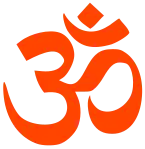Hitā
Hitā (Sanskrit: हिता) means 'causeway' or 'dike'.[1] In the Upanishads this word is used to mean 'subtle connections' or 'canals of subtle energies', or particular 'nerves' or 'veins'.[2] The journey to the heart is said to be through seventy-two thousand subtle channels called Hitā;[3] they are the beneficent active veins (filled with different types of serums).[4]
| Part of a series on |
| Hinduism |
|---|
 |
|
| Part of a series on | |
| Hindu philosophy | |
|---|---|
 | |
| Orthodox | |
|
|
|
| Heterodox | |
|
|
|
Dilemma of Balaki
Proud Balaki skilled in expounding, eloquent, went to Ajatsatru, the King of Benares, to impart superior wisdom to him which he knew only as the conditioned Brahman; he knew about the physical and physiological categories and therefore, the king soon realized that Balaki did not know about Brahman. Balaki was not aware of the fact that whatever he knew was the result of ignorance, that the results of ignorance, being finite things, are separated from him. Ajatsatru then tells Balaki Gargya that reality is to be found in the deep-sleep-consciousness. Pippalada, the sage of the Prashna Upanishad, holds that sleep is caused by the senses being absorbed in that highest 'sensorium' the mind, which is why in deep sleep man is not able to hear, not to see, nor to smell because the mind is then merged into an ocean of light.[5]
Doctrine of deep-sleep-consciousness
Sankara explains that Balaki knew only about those phases of Brahman that consist of name, form and action which have to be known in the sphere of ignorance. Therefore, in the context of deep-sleep-consciousness, Ajatsatru reiterates that the being full of consciousness in sleep absorbs the functions of the organs through its own consciousness and lies in Akasha that is in the heart. The heart is the seat of the intellect, the internal organ, and the other or external organs are subject to that intellect abiding in the heart. What is seen in a dream are not the attributes of the self. That conscious being, who has identified itself with action, its factors and its results due to the limitations of name and form and is superimposed by ignorance, virtually comes back to the body in the manner described in the Brihadaranyaka Upanishad:-
- अथ यदा सुषुप्तो भवति, यदा न कस्यचन वेद, हिता नाडयो द्वासप्ततिः सहस्त्राणि ह्र्द्यत्पुरिततमभिप्रतिष्ठन्ते,
- ताभिः प्रत्यवसृप्य पुरीतति शेते; स यथा कुमारो वा महाराजो वा महाब्राह्मणो वाति ध्नीमानन्दस्य गत्वा शयीत, एवमेवैष एतच्छेते ||२.१.१९||
- "Again when it becomes fast asleep – when it does not know anything – it comes back along the seventy-two thousand nerves called Hitā, which extend from the heart to the pericardium (the whole body), and remains in the body. As a baby, or an emperor, or a noble Brahmana lives, having attained the acme of bliss, so does it remain." – (Brihadaranyaka Upanishad II.i.19)
- …अस्यैता हिता नाम नाडयोऽन्तर्ह्रदये प्रतिष्ठिता भवन्ति, एताभिर्वा एतदास्त्रवतिः तस्मादेष प्रविविक्ताहारतर इवैव भवत्यस्माच्छारिरादत्मनः ||४.२.३||
- ".. In this body there are nerves called Hitā, which are placed in the heart. Through these the essence of our food passes at it moves on. Therefore the subtle body has finer food than the gross body." – (Brihadaranyaka Upanishad II.i.19)
- ता व अस्यैता हिता नाम नाडयो यथा केशः सहस्त्रधा भिन्नस्तावताणिम्ना तिष्ठन्ति, शुक्लस्य नीलस्य पिङ्गलस्य हरितस्य लोहितस्य पूर्णा;....||४.३.२०||
- "In him are those nerves called Hitā, which are as fine as a hair split into a thousand parts, and filled with white, blue, brown, green and red (serums). (They are the seat of the subtle body in which impressions are stored)…" – (Brihadaranyaka Upanishad II.i.19)
The experience of the waking state is seen in dreams. The Taijasa is nourished by finer food than the Vaisvanara. And, ignorance is not the natural characteristic of the self. All impressions due to the experience of high and low attributes of the relative universe are centred in the subtle body where they are stored.[6]
Implication
Swami Nikhilananda explains that the self that functions in the 'waking state' is Vaisvanara, which in the 'dream state' is Taijasa and in the 'dreamless-sleep state', Prajna; Viraj (matter) unites with this self identified with Indra in dreams when there is no distinction between the experiencer and the object of experience. In deep sleep the Atman, limited by Prana or vital breath, is called Prajna.[7] The subtle body in which the impressions that are stored in the body owing to the contact with the serums filled in the Hitā undergoes modifications under the influence of past merit and demerit, and in dreams falsely manifests itself as impressions in a variety of forms. When ignorance is eliminated and knowledge reaches its perfection, the state of identity with all ('liberation') is attained.[8]
References
- "Sanskrit Dictionary". Spokensanskrit de.
- Stephen H. Phillips (2009-05-20). Yoga, Karma and Rebirth. Columbia University Press. p. 342. ISBN 9780231519472.
- Ram K. Piparaiya (2003). Ten Upanishads of Four Vedas. New Age Books. p. 121. ISBN 9788178221595.
- Subodh Kapoor (2002). Encyclopaedia of Upanishads and Its Philosophy. Genesis Publishing. p. 543. ISBN 9788177553642.
- R.D.Ranade. A Constructive Survey of Upanishadic Philosophy 1986 Ed. Bhartiya Vidya Bhavan. p. 33,89,185. OCLC 799119712.
- Brihadaranyaka Upanishad. Advaita Ashrama. p. 198,412,457.
- The Principal Upanishads. Courier Dover Publications. January 2003. p. 225. ISBN 9780486427171.
- Brihadaranyaka Upanishad. Advaita Ashrama. pp. 457–459.